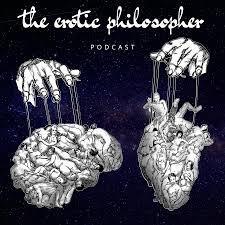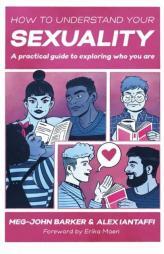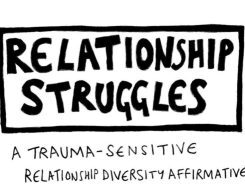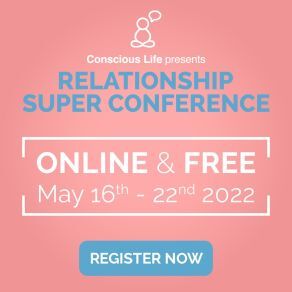Meg-John Barker's Blog, page 3
December 30, 2022
More free books – happy new year!
As well as making a few zines in 2022, I also managed to finish my project of creating free books out of my old blog posts and other pieces published in various places since I started blogging.
In 2021 I published free books on Plurality, Trauma, and Consent – the main themes which I’d been blogging about during the pandemic. The new free books go back further in time to cover the themes I’ve been writing about since I began blogging, particularly gender, sex, relationships, and mental health.
As with my latest zine (which I made five years on from making the first Plural Selves zine) these free books mark an imporant anniversary for me. It’s a decade on from 2012: the year when I published the first edition of Rewriting the Rules (my first self-help style book) and started blogging.
It feels helpful, somehow, to bring all the material from this vital period of my life together, and – perhaps – to draw a line there, marking a turning point towards what I might create in the future. Whatever that is will be deeply shaped by this time of external and internal emergency/transformation/paradigm shift, and my learnings from that experience, and from others who are writing on such themes.
CaveatI begin each of the new free books with a caveat that some of the earlier pieces may not represent (all of) my current thoughts and feelings on these topics. I’ve learned so much more from my own experiences, and from engaging with other people’s work, in the last ten years.
I hope – as with my older published books – that people will read these free books mindful of the time and context in which some of the content was written, and with compassion for the places where the language or ideas are limited and/or have now been replaced with something more inclusive, nuanced, or helpful.
The BooksHere’s a list of the new free books, and what you can expect to find in them:
RelationshipsThis book contains all my writing on love and relationships. It goes back furthest because these topics were the focus of most of my first blog posts after Rewriting the Rules was published. It also includes some of my most recent writing on slow relating and break-ups.
The book is divided into sections on love (mostly the impact of cultural love norms or amatonormativity), crushes and new relationship energy, slow relating, monogamy and non-monogamy, conflict and communication, and break-ups.
This book is hopefully a good companion to my published books Rewriting the Rules, The Secrets of Enduring Love (with Jaqui Gabb), and How To Understand Your Relationships (which Alex and I will hopefully be writing next year).
Download here.
SexThis book contains all my writing about sex. It’s divided into sections on sex ed, sex advice, sex in relationships (particularly sexual incompatibility), sexual desires, sexual practices, and BDSM/kink (the theme of by far my most popular blog posts for some reason!)
This book, and the relationships and feelings ones, contain versions of several of my summary posts from The Meg-John & Justin podcast, (with links to where you can listen to the audio episodes) as well as posts from this website and elsewhere.
This book is hopefully a good companion to my published book with Justin, Enjoy Sex (How, When and IF You Want To) as well as to the next free book – and published books – on sexuality.
Download here.
SexualityThis book starts with a general section which covers figuring out your sexuality, coming out, and the diversity and fluidity of sexuality. Then we have sections on heteronormativity and heterosexuality, bisexuality and pansexuality, queer issues (like nature/nurture and same-sex relationship recognition), further sexualities (like kink and sapiosexuality), and porn.
This book is hopefully a good companion to my graphic guides on Queer and Sexuality (with Jules Scheele), as well as Alex and my How to Understand Your Sexuality.
Download here.
GenderLike sexuality, this book starts with a general section which deals with gender diversity and fluidity, my vision for gender affirmative and inclusive therapy, and the future of gender. Then we have sections on trans (including pieces on the trans moral panic, trans time and space, and trans sex) and on non-binary genders (including my post coming out as non-binary in 2015!) The book ends with a couple of older pieces about understanding masculinities and femininities.
This book is hopefully a good companion to my graphic guide to Gender (with Jules Scheele) as well as to Alex and my How to Understand Your Gender, Life Isn’t Binary, and the edited collection Non-Binary Lives.
Download here.
Mental HealthThis book includes most of my writing about madness and mental health which isn’t specific to trauma (which has its own full book).
The mental health book starts with a number of general articles covering my thoughts on mental health, mostly focused on why we need to understand it at a sociocultural and sociopolitical level, as well as at the level of individual experience, and why we need to challenge mad/sane and ill/well binaries. After this, the book includes sections on mental health and relationships, self-help, mindfulness, and depression.
I also included a section on new year resolutions towards the end of this book because I’ve written so many pieces about this over the years, and because I wasn’t sure where else to put them! My critiques of new year resolutions are quite similar to my critiques of self-help and self-improvement more broadly. This book ends with a short piece on therapy, and a couple of pieces that touch on plurality and madness – another topic that has its own free books.
These books, and the next one, are hopefully good companions to Alex and my book Hell Yeah Self-Care!, my book on Mindfulness, and Jules and my forthcoming graphic guide on trauma and mental health (hopefully arriving 2024).
Download here.
FeelingsLinked to the mental health book, the free book on feelings covers emotional struggles and emotional experiences more broadly. It starts with a couple of earlier pieces about being with feelings, which eventually lead to my Staying With Feelings and Welcome Monster Feelings zines. Then there are a number of posts about happiness and why we might be suspicious of approaches that encourage us to strive for happiness.
After this there’s a section about other feelings include anger, failure, gratitude and more. Several of these posts are more personal reflections on my own experiences, as are the three ‘memorial’ posts on themes of loss and grief that follow. This book ends with another short piece about therapy, including ideas and practices from some of the main therapy approaches.
Download here.
WritingThe shortest free book is on writing – something that I plan to write plenty more about. But I was able to find 50 pages which seemed enough for a brief book (the others are mostly around 100 pages long).
This book starts with my essay about queer writing and writing queerly (for anyone, not just for queers!) and includes a few other pieces about how I write and my advice for people who want to start writing. In this book I’ve also included some material about journalling and zining, as well as a piece I wrote about purpose and integrity.
Download here.
You can find links to all of the free books here.
The post More free books – happy new year! appeared first on Rewriting The Rules.
December 21, 2022
Zine-Maker: The Gift of Zines
Announcing one final new zine of the year: The Zine-Maker zine.
Last week I was invited to Cardiff to facilitate a workshop on zine-making. I thought I’d get meta and make a zine for the workshop about zine-making. I figured it’d be a nice thing for people to take away, as well as giving an opportunity for anyone who couldn’t make the workshop to work/play through it in their own time.
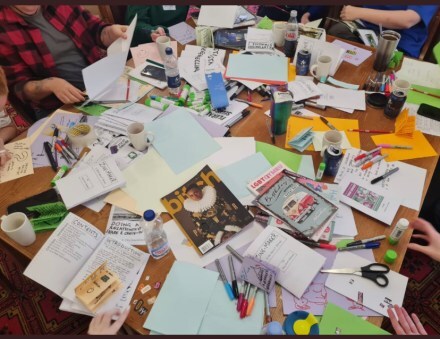 What’s in the zine
What’s in the zineThe Zine-Maker zine introduces you to the idea of zines and where they come from. It helps you to figure out whether zine-making might be for you and – if so – what kinds of zines, or – if not – what alternative kinds of creativity might be a better fit. Then it takes you through a couple of quick warm-ups for your word-making and image-making (as well as a bunch of alternatives if these things aren’t for you). Finally, it gives you practices for making three zines/zine fragments/zine plans.
You can take a few hours alone – or with friends – to work/play through the zine as a workshop. Or you can just read it through, or dip into it, whatever works for you.
Who inspired the zineIn preparing this zine I read more of Lea Cooper’s wonderful series about zines, In the Zine House (and Carmen Maria Machado’s amazing book In the Dream House, which inspired Lea’s title). Lea’s words particularly helped me to understand the mad, crip, queer potential of zining.
I also read Stephen Duncombe’s excellent analysis of zines and art activism, Notes from Underground. I was fascinated to find out more about the roots of zine-making in both sci-fi fandom (which resonates hard as I’m currently watching everything Star Trek) and in the punk scene.
As well as embracing the DIY ethos of zine-making, both fandom and punk encourage their audiences to break down the hierarchies between creators and audiences by writing their own stories and/or making their own music.
Personally, slashers and other fan-fic authors take mainstream media into their own hands, often making fiction that is queerer that mainstream media is able to produce. Punk and Riot Grrrl resist the capitalist music industry by insisting that everyone can make their own music.
Politically, sci-fi and punk also both challenge the normative status quo, imagining futures where things are done radically differently, particularly in terms of the hierarchies that a drawn between what/who is considered valuable and what/who is not.
In the Zine-Maker zine, I bring Natalie Goldberg and Lynda Barry into dialogue with zines. Both authors present a radical alternative to conventional advice about words (Natalie) and images (Lynda). They suggest that we should dismantle normative ideas about what makes good, successful writing or pictures, and instead return to our ‘beginner’s mind’ or the child parts of us who knew/know how to play with words and images.
Finally, I love these words from Yarrow Magdalena which I include at the end of the zine.
I love thinking of zines as spells that can travel throughout the world to tell stories and share skills and knowledge … You can hide inside them when things get tough and you can experience another person’s world intimately or escape into some place brighter than your own. Zines give us a chance to shift the narratives we’re exposing ourselves to and to water the kinds of creative eco systems that are more aligned with our values than mainstream media. – Rituals, Yarrow Magdalena
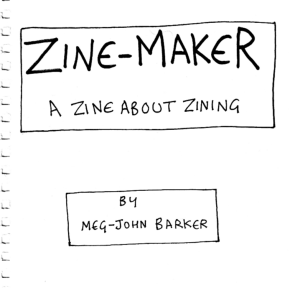 The gift of zine
The gift of zineIf you’d like to give the gift of zine, or of zine-making, feel free to download and share the Zine-Maker zine here.
The post Zine-Maker: The Gift of Zines appeared first on Rewriting The Rules.
November 25, 2022
All about Zines
2022 has definitely been the year of the zine for me. I’ve published five new zines over the course of the year, I’ve just been included in a couple of great articles about zining, and I’m about to facilitate a zine-making workshop in a couple of weeks. I just rewrote my website biography to include ‘zine-maker’ as one of the main things I am. I thought I’d take the chance to share my newest zine here, as well as some thoughts on why zining is so important to me.
New zine!The zine I’ve just published is called Plural Selves 2. I made the first Plural Selves zine back at the end of 2017. It feels very meaningful to revisit this topic five years on from then, after what has been a pretty epic journey in understanding my own plurality and how it relates to trauma.
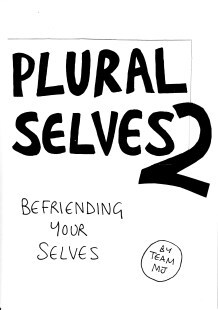
The first Plural Selves zine introduced the idea of plurality – that our selves can be usefully understood as multiple rather than singular. It suggested a lot of different practices and forms of play that you might try in order to locate your own plural selves and to improve communication between them.
Plural Selves 2 is a more in depth exploration of the different kinds of selves that you might uncover and how they operate together in a system. The zine touches on a number of plurality models, before going through the model that I’ve developed from my own experience of plurality: that we have cover-up (foregrounded), carrier (backgrounded), and container selves. I introduce my seven selves and their journeys, and include workbook pages for how you might explore and connect with similar selves in yourself – if you have them.
I’m hoping to follow up Plural Selves 2 with a couple more zines on plurality. One will explore in more depth all the different ways in which you can communicate, or relate, between your selves. The other one will explore how plurality shows up in our relating with others, and how we might get more conscious about that to address the ways in which relationships can be/come traumatised/traumatising, and hopefully improve our relationships with others, in our communities, and with the world.
Other zines
The other zines that I made this year were:
Welcome Monster Feelings: A collection of colourful drawings of my emotions depicted as monsters.Welcoming Your Monster Feelings: A zine about how to do the practice of welcoming your emotions as monsters (and drawing, writing, dancing, acting, or otherwise expressing them).Relationship Struggles: A zine about the diverse ways of doing relationships that are out there, and how no one true relationship – or relationship style – will fix our relationship struggles. We need to explore how we relate to do that, including reflecting on trauma, consent, and conscious connection.PIERS(c) Relationship Check-In: A zine about how to do a share, or check-in, in a relationship with another person, or group.Other zines I’d love to make in the coming months and years include ones on shame, on existential approaches to trauma, on surviving traumadoes, and on various multi-layered ways of understanding ourselves and our relationships as embodied and embedded – beyond the sense of separate individuals acting on each other.
All about zines
The two pieces that just came out about zining, which mention my work, are:
Lea Cooper‘s great series for The Polyphony about health-related zines: In the Zine House . My zines get a mention in the article on self-care zines, In the Zine House: The Bathroom. Gemma Lucas’s lovely blog post about the collaborative workshop we did last year on Moving Shame , including Elizabeth Fortnum‘s amazing collaborative zine based on what came out of that workshop.Why zines now?
Heading towards facilitating a new workshop about zining, I’ve been reflecting again on why zines are so important and helpful for me, especially now. It’s something I have written about before in this interview with Helen Spandler, and in this interview between two of my selves (the one currently writing this and another one!) about Welcome Monster Feelings.
The most important thing at the moment is that zine-making feeling possible, and helpful, through a period of severe trauma/madness/mental-health crisis. When things are so emotionally hard, many things that I would have done before feel somewhere on a spectrum from challenging to completely impossible. This can make struggles worse when it means that I can’t do the things I would previously have done to feel that my life was meaningful, to connect with others, and to find that sense of presence – or flow – that comes with creativity (three things that are often agreed to be important for emotional well-being).
MeaningI’ve often found my sense of meaning through writing for others, particularly by weaving together all of the ideas and practices which I’ve personally found helpful, and presenting them in ways that are hopefully accessible and engaging to those who might not otherwise come across them (because they don’t often get out far beyond the academic, activist, therapy, or spiritual communities in which they originate, or – if they do – it’s not in a language that is easy for others to understand).
Big writing projects feel overwhelming for me during times of struggle and crisis, especially ones aiming towards a polished product like a book. There’s a lot of fear of ‘getting it wrong’. Zines feel more manageable because they’re meant to be short and DIY. The zine format models that it is okay – inevitable in fact – that we are messy and imperfect. It’s fine to produce a few pages and put them out there as they stand, with false starts and tippex marks, for example.
For me zines are also something I can put out in an invitational way. Mine are free for anyone to access, and people can donate me some money only if they enjoy them and can afford to. That feels less pressurising (for me and hopefully also the reader) than the format of published books which have to be purchased. It also recognises both that my stuff in particular, and zines in general, are not for everyone. We all resonate with different ideas and experiences, and different mediums are more or less helpful to us depending on where we’re at in terms of neurodiversity, disability, trauma responses, and all kinds of other things. Comic style zines work for me partly because I’m quite visual, enjoy words and pictures together, and respond well to the weaving together of ideas and lived experience. Other people will find that podcasts, books, audio zines, video clips, or other mediums are a way better fit for them.
ConnectionConnecting with others can be really difficult during periods of crisis, because part of how (relational) trauma works is that other people feel threatening and a potential source of unbearable shame or attack. Our worlds can often shrink to only those we have safe-enough, trusting relationships with, and even they can feel shaky at times. For me this means that many of the ways in which I used to connect one-to-one and in groups are off the table for the moment.
It is much easier for me, at such times, to communicate through writing (and images) – where there is a lot of time and space for me to get my thoughts and experiences down in a way that conveys them accurately, and then a lot of time and space to let any response land with me, rather than having to engage in (written or face-to-face) conversations in real time.
Zines have been a wonderful way to connect with other people during this time, to get across my experiences to others in ways they might connect with, and to still feel part of things – like Gemma’s small collaborative workshop, or Lea’s series about zines – even as I’m still in retreat from the world much of the time.
I am going to brave facilitating this zine-making workshop soon, and have managed a couple of these online over the last couple of years. Somehow inviting people to try various forms of zine-making feels more comfortable than the kinds of events or workshops which I used to run, where there was more of a hierarchy between an ‘expert’ speaker/facilitator, and the audience/attendees. There’s something about both where I’m at, and where the world is at these days, which makes the model of co-creation or collaboration feel more comfortable to me. I’m so aware of all the different wisdoms that everyone holds, and of not wanting to value some more highly than other. I’m also so aware of just how vulnerable so many of us are, and the kind, tender, invitational spaces we might need in order to express ourselves, and feel held and heard.
Presence/FlowFinally, zine-making has felt like a place where I can find glimpses and glimmers of presence or flow during a time when overwhelming emotions and my struggles with these have made that rare and hard to come by.
Part of this is that it’s possible to easily do just a zine page – or part of page – at any moment when I do feel okay. I can also separate out the stage of planning the next bit of a zine (often walking or staring out of the window) from the stage of drawing it, from the stage of inking it, and eventually scanning it (both of which latter activities don’t require me to be in such a good place).
It’s possible to make zines very slowly, and still get a rewarding sense of something building up over time.
Also the kinds of zines I make don’t always have to be made when I am in a good place. The Welcome Monster Feelings zine was so helpful because I could draw specifically when I was having a difficult feeling – that was the point. The Plural Selves 2 zine included illustrating the parts of me who struggle, and how they struggle. It’s still hard to draw when there are extremely painful processes going on, but zine-making offers to potential – for me – to value painful experiences, to see how getting them down on paper is helpful to me, and to get the sense that they might help others to feel less alone, or to understand their experiences better, through engaging with the zines.
Zining FuturesThrough a tough time like this it is very easy to focus on the different place that you hope to get to, or the different person you’d like to be once you’re out the other side, whether that is a place and person like the one before the trauma hit, or the one you imagine you might be after it has passed. It seems cruel that such thinking often makes the tough time even tougher, because it involves struggling against how things are, and giving yourself yet more messages that you are not okay unless you are ‘healed’ or ‘fixed’ and are able to get ‘back to normal’ or to a somehow better, improved version of who you are now.
Just as the various global crises we’re in the midst of are unlikely to get better, or back to normal, I’m trying to view myself in the same way, and embrace the uncertainty and not-knowing of what might be ahead. Part of this is coming to see myself as a zine-maker, rather than a zine-maker on the way towards being something more ‘proper’, or on the way back to some kind of normal – of all the things that I used to do.
I’m deeply grateful to all the other people – in my life and beyond – who model similar ways of being okay with who and how they are to me, as well as to those who have engaged and connected with me through my zines. These are the kind of vital, delicate threads that keep us going through such tough times. Thank-you so much.
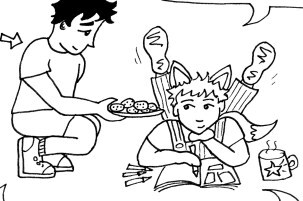
I might even make a zine about zining at some point. Watch this space…
The post All about Zines appeared first on Rewriting The Rules.
September 12, 2022
Interview about Sexuality: A Graphic Guide
Thanks so much to David Hopper at Giddy for interviewing me recently about Jules Scheele and my book Sexuality: A Graphic Guide.
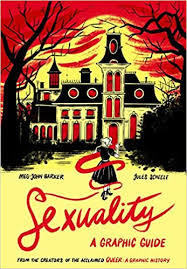
In the interview we explore the myths and misconceptions about sex and sexuality which we wanted to confront in the book, the problems with the idea of sexual ‘dysfunction’, and what Jules and I are hoping to achieve with our contributions to Icon’s graphic guide series.
You can find the full interview here.
Between the Pages: ‘Sexuality: A Graphic Guide’Author Meg-John Barker explains why the comic book medium is perfect for exploring sex.Written by
From the creators of graphic books, “Queer: A Graphic History” and “Gender: A Graphic Guide” comes “Sexuality: A Graphic Guide.” Published in 2021 by Icon Books, the 176-page comic book offers an informative and inclusive look at sexuality.
Writer Meg-John Barker and artist Jules Scheele, who both use they/them pronouns, take the reader on a Scooby-Doo, gang-like journey as the book’s four main characters encounter monsters like patriarchy, heteronormativity, ableism and white supremacy. The book is packed with quotes from (and illustrations of) leading sex researchers and theorists, helping make academic topics more accessible and fun.
Barker is the author of various+ books on sex, gender and relationships, including “Life Isn’t Binary,” “How to Understand Your Gender,” “Enjoy Sex (How, When and IF You Want To)” and “Rewriting the Rules.” You can read their blog at www.rewriting-the-rules.com.
In this exclusive interview with Giddy, Barker discusses the common sexuality myths they wanted to dispel, why a focus on sexual “dysfunction” is problematic, Scheele’s eye-catching illustrations and more.
Editor’s note: This interview has been edited for length and clarity.
What would you say is the purpose of the book as well as the intended audience?Barker: Our aim was to provide a friendly, accessible guide to the various ways of understanding sexuality that are out there. Particularly, we wanted to highlight how the normative ways of understanding it in our culture at the moment are only one possibility, and often a not particularly helpful or accurate one. Read more…
The post Interview about Sexuality: A Graphic Guide appeared first on Rewriting The Rules.
August 8, 2022
Another new zine! Relationship shares and check-ins
We’re on a bit of a roll with relationship tech zines at the moment. After the last one on Relationship Struggles (all about relationship trauma and what we can learn from various kinds of relationship diversity to help with this), this new one covers various ways of doing individual sharing and process check-ins in relationships of all kinds (one-to-one and groups).
It seems appropriate to be thinking so much about relationships, given this upcoming time with co-author Alex Iantaffi likely planning (but not yet writing!) our next book How to Understand Your Relationships.
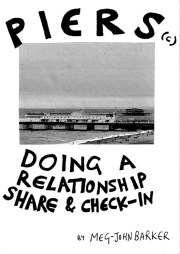
This new zine explains the importance of three kinds of time together in one-to-one and group relationships: Alongside Time, Individual Sharing, and Relationship Process. It covers one sharing method in detail: PIERS(c) where you share about yourself and your current life under the themes of: Physical, Ideas, Emotional, Relational, and Spiritual (or Self Path).
The (c) stands for relationship check-in and is an invitation to consider whether you are both/all up for doing any relationship process conversation, such as talking about any dynamics you’ve noticed, or repairing minor ruptures. The (c) can also be an opportunity to check-in about headlines you’d like to cover in the rest of the conversation between you, or alongside activities you’d like to do together and how.
You can download the zine here if it’s of interest.
The post Another new zine! Relationship shares and check-ins appeared first on Rewriting The Rules.
July 25, 2022
Pleasure and trauma on The Erotic Philosopher
In two weeks time I’m going to see my co-author, Alex Iantaffi, for the first time in person in nearly three years! Our last time together was at the Non-Monogamies and Contemporary Intimacies (NMCI) conference in Barcelona at the end of 2019 (you can check out our presentation here). It’s a massive understatement to say that much has happened in our lives at every level since then. It feels huge to finally be able to be together again.
It’s good timing, then, that our episode for The Erotic Philosopher podcast, with Cyndi Darnell, just came out. In this episode Alex and I draw on the book we wrote, via zoom, during the pandemic: How to Understand Your Sexuality. We cover how erotic, like other kinds of, pleasure is heavily constrained by both cultural and relational forms of trauma. These include the social norms and messages we receive about sex, and the patterns we develop to relate with others and ourselves (including our bodies and feelings), growing up.
You can listen to the podcast episode here. You can buy How To Understand Your Sexuality here. There’s more on trauma in my free book here.
Alex and I are hoping to spend most of our time together relaxing (Hell Yeah, Self-Care!), but it seems highly probable, knowing us, that we’ll also be starting to plan and scheme for our next book together, How to Understand Your Relationships. This book will explore how we can relate with others (and ourselves), expanding our capacities against a backdrop of so much cultural and personal trauma around relationships. I’ve written a bit about some of these themes in my new zine, Relationship Struggles.
The post Pleasure and trauma on The Erotic Philosopher appeared first on Rewriting The Rules.
June 28, 2022
Queer joy
I wrote a new post on queer joy for Pride month on the JKP blog: Why do we need to queer joy (and pride), what does that mean, and why does it need to include the whole rainbow of LGBTQIA+ and the whole rainbow of feelings?
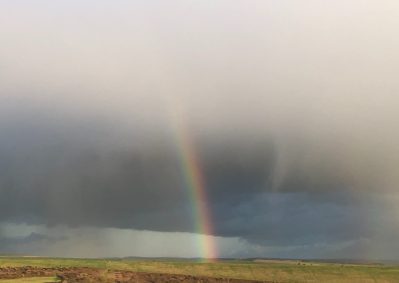
When JKP asked me to write a piece on queer joy for Pride season my immediate response was ‘you’ve got to be kidding.’ After these past two years, how can a focus on joy – or pride for that matter – be anything but a deluded kind of ‘back to normal’ dream: a dangerous denial of what we’ve been through, what we’re still going through? On reflection though I began to wonder about receiving the phrase ‘queer joy’ as an invitation. What might it mean to queer joy?
Queer umbrellas
If we take queer as a noun – an umbrella term for our LGBTQIA+ community – then it’s hard to find much joy. At a cultural level, the pandemic disproportionately impacted queer people’s mental health and queerphobic hate crime soared. The recent government U-turns on banning conversion therapy, and subsequent decision to do so only for sexual orientation, reflects the ongoing moral panic against trans folks, and how intersex and a-spectrum people are rarely included under the LGBTQIA+ umbrella in more than name, given that erasing practices for these groups are some of the most extreme and commonplace.
The impact of living through this time has been even greater for those – many of us – whose queerness intersects with other marginalisations: disabled folks who’ve seen COVID policies and practices centre abled people and treat them as disposable; those who the current economic crisis is pushing into ever-deeper levels of poverty; and people of colour – also disproportionately impacted by the pandemic, rises in hate crime, and endless cultural gaslighting of their experiences past and present.
At a community level, this has all taken a massive toll. In the last year alone, my close communities have seen six deaths, all related to mental health struggles rather than COVID itself.
While we might want to tell joyful stories of queer communities drawn closer during a time of crisis, the truth – for many of us – is the opposite. Understandably, given our experiences of both cultural trauma, and frequently the developmental trauma of not being fully accepted by our close people growing up, many of us have fallen back on our unconscious survival strategies: attacking outwards – blaming and ostracising those who seem to be hurting, abandoning or endangering us; attacking inwards against ourselves, or crossing our own – or others’ – boundaries in attempts to get our needs met; withdrawing into smaller and smaller zones of safety; and/or avoiding pain by distracting ourselves, distancing from those who’re struggling, and rushing ‘back to normal.’ Read more…
The post Queer joy appeared first on Rewriting The Rules.
May 19, 2022
New zine! Relationship Struggles
Launched today, another new zine! This one is about relationship struggles.
The zine suggests that we often locate any pain and difficulties that we experience in relationships as being something ‘wrong’ with that particular person, or with that particular way of doing relationships (e.g. monogamy or polyamory).
What if it wasn’t the what that was the problem, but the how? What if pain will keep showing up in our relationships (of all kinds and with any people) until/unless we attend to that pain, and address how we are relating?
This zine suggests that we all carry relationship trauma from the existential challenges of relating, from the toxic structures and messages about relationships in our wider culture, and from the development of our particular ways of relating in our family context. This trauma remains in our bodies and impacts how we relate now.
We then explore what diverse relationship styles might have to offer to a more trauma-sensitive way of doing relationships. We consider how learning how to love in a more conscious, consensual, mutual way could be seen as a lifelong journey through all types of relating.
You can download the zine here.
The post New zine! Relationship Struggles appeared first on Rewriting The Rules.
May 6, 2022
Relationship Super Conference
The relationship super conference is happening again from May 16th to 22nd.
It’s an amazing free online event covering a huge diversity of relationship-related topics, and including talks by some of the people I regularly mention here: Alex Iantaffi, Sophia Graham, and Justin Hancock, as well as Ruby B. Johnson, Kevin Patterson, and Liz Powell who I met at the Poly Dallas conference back in 2018.
In my interview I spoke about a number of topics that I’m hoping to cover in a new relationship diversity zine – coming soon!
How we need to understand relationships – and relationship struggles – through the lens of cultural and developmental trauma.Relationship diversity, and why this model is more helpful than binaries when it comes to relationships.Why we need to focus more on how we relate, than who we relate with or what relationship style we subscribe to.How our relationships with ourselves, others, and the world are interconnected.You can check out my talk on day 2 of the conference, May 17th.
Sign up to the event here. Download the free Relationship Superconference Guide here.
The post Relationship Super Conference appeared first on Rewriting The Rules.
April 27, 2022
On monsters, emotions, and drawing: An interview with the artist behind the zine ‘Welcome Monster Feelings’
This post describes the thinking and feeling behind our new zines Welcome Monster Feelings, and Welcoming Your Monster Feelings.
It takes the form of an interview between the part of me who created it – Fox – and another part – James. If you haven’t read one of my plural blog-posts before and aren’t sure who these people are, feel free to check out our Plural Selves zine, and our free book about Plurality. But hopefully you don’t need to get that part in order to find the content here interesting.
Location: Fox’s favourite cafe.
Food: Halloumi tomato pesto sandwich, OJ.
James: It’s my great pleasure, today, to be conducting an interview with the artist behind the new zine Welcome Monster Feelings. Thankyou for taking the time to speak with me today Fox.
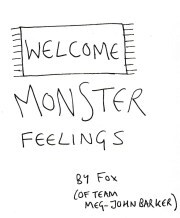
Fox: You’re welcome.
James: Would you like to begin by telling the readers a little bit about who you are?
Fox: Nope.
James: Well this is getting off to a great start.
Fox: I think it’d be more fun if you say who I am and I’ll say who you are.
James: Oh go on then. How best to describe you?
Fox: It better be good.
James: No pressure then.
Fox: *giggle*
James: I would say that you’re the youngest child part of our plural system. Or rather we tend to think of you as who we might have been without all the rules we learnt about who it was okay and not okay to be in the world – without our developmental trauma. You are the most able of all of us to just be in the moment, to find delight and wonder in things, to move through the feelings you have rather than getting stuck in them. How am I doing?
Fox: Why do we call me Fox?
James: Because you often feel more like a creature than a human: a wild little thing.
Fox: Heh I like that. Okay I’ll do you.
James: I’m not sure it’s regular to introduce the interviewer.
Fox: I’m gonna anyway. You’re our James. We call you lots of other names like Old Man and Saint James and Captain Admin and ruder ones.
James: Captain Admin is pretty rude. I don’t just do admin.
Fox: That’s why it’s funny. You are the one of us who does most of the everyday life stuff, particular the bits that the rest of us find boring or scary like emails *shudder* But you’re also the main one who looks after the child parts of us: me, Morgan (aka Beastie), and Robin (aka Tony). You’re really good at that.
James: I’m not sure how Morgan would feel about being called a child part.
Fox: She’s not here!
James: I mean technically, given that we share a body…
Fox: If she was properly here we wouldn’t be doing this interview coz it’s not easy for her to do this kind of thing. But we’ll get to that.
James: Is that enough introductions then? Am I allowed to start the interview proper?
Fox: It’s about time!
The aims of the zine
James: *shakes head* Okay then. First question. What were you hoping to achieve with this work Welcome Monster Feelings?
Fox: Two things I think. The main one was I wanted to help the other members of our system – particularly Robin and Morgan who carry most of our trauma – to find a way to be with their most painful feelings. We’ve been in this big trauma period for the last few years, so our feelings can be very overwhelming at times, especially for those two.
The other thing I wanted to do was to find a way back to drawing. We made quite a few zines and comics a few years back, but it was something we found much harder to do during the trauma time.
James: Why d’you think that is?
Fox: Well Morgan’s trauma often comes out as being an inner critic – so it’s very hard for her to let us draw without feeling it’s not good enough, or comparing it to what other people do, even though she also really wants us to be creative. Robin’s trauma comes out as fear and shame so it’s scary for him to put stuff out there in the world, in case people are mean about it. Also it’s just generally pretty hard to sit down and draw – or do anything much – when you’re feeling that bad.
James: I think it was a genius move to find a project that we could do even when we felt rotten, in fact tough feelings were kind of a bonus.
Fox: I know right? And – as we say in the companion zine Welcoming Your Monster Feelings – the practice of making the monsters often helps overwhelming feelings to calm down a bit. So you gradually get this knowing in your body that making a monster will make you feel better, which makes it easier to do it the next time you feel rough.
James: Positive reinforcement.
Fox: Right, and I love that it showed Robin and Morgan that they were vital – to the project and to us. They can both so easily feel that they are ‘bad parts’, or ruin things for the rest of us, and that they should be cast out again – as they both were for so much of our lives. But I couldn’t have done this project without them. It was their feelings I was drawing most of the time.
Also when we showed our friends, and they found it helpful and said they felt similar things, that helped Robin and Morgan to feel seen, and less alone, and like they were being helpful to others.
A plural project
James: Just brilliant! So it sounds like you see this as a plural collaboration, even though you were definitely the one leading on it.
Fox: Absolutely. Robin and Morgan mostly had the feelings, and told me about them, and then I found the way to draw them that felt most right. But we also got everyone else’s feelings in there somewhere.
James: I particularly like the holding and hearing monster towards the end…
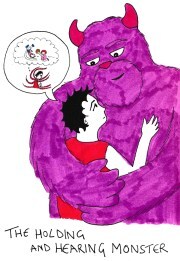
Fox: That’s you! And he looks a bit like Sully from Monsters Inc because that character reminds us of you, and his full name is James P. Sullivan.
James: I also helped as Captain Admin right?
Fox: Yes! You did all the scanning and the making it a pdf, and learning how to make a pdf small so people can download it, and putting it on our website, and all kinds of things that I find an-noy-ing!
James: And conducting this interview of course.
Fox: Of course. Next question.
Feelings, art and monsters
James: Well I was interested in exploring with you the links in our life between feelings, art, and monsters. I know you’ve been reflecting on that.
Fox: I have. It feels like we’ve been trying to do this project our whole life, and it involves going back towards these three things that were all kind of crushed in us.
James: Do go on.
Fox: Well we’ve written before about how we weren’t allowed ‘difficult’ feelings as a kid. People at home and school tried to train us out of them with punishments for unacceptable emotions, and rewards when we made it through the day or week without crying. That’s part of the reason that Robin and Morgan got disowned. They held all the least acceptable feelings: fear and anger, but also loneliness, sadness, jealousy, pride. All sorts.
James: Right. Our feelings get so unbearable during the years in our life when PTSD hits because we’re feeling all the things that were locked inside Robin and Morgan.
Fox: Feeling the feelings they held for us our whole life. That’s it.
Another thing that got pushed out of us in a similar way when we were small was art. We LOVED drawing. We drew all of the time. Our bedroom wall was full of our pictures. But gradually people around us tried to make us draw the kinds of things they wanted, and to draw in the ways they wanted us to.
James: For example?
Fox: Like being asked to draw pictures as a present for people’s birthdays. And they generally wanted things like landscapes or still lifes or whatever, which isn’t what we enjoyed drawing. Also when we did art at high school we were shocked because we had to draw things from real life rather than out of our imagination – as we’d always done before.
James: What did we enjoy drawing?
Fox: Mostly people and imaginary creatures. And we drew to tell stories from our fantasy life, or to get down feelings that we couldn’t talk about or express in other ways. But eventually we learnt that wasn’t how you were meant to do art.
James: So, not only were both feelings and artistic pursuits suppressed, but those two suppressions were also related. Losing the ability to draw from our imagination and feelings denied us an important outlet for emotions we weren’t supposed to have. How do monsters fit in?
Fox: Monsters feel like the third leg of the stool somehow.
We were always fascinated by monsters. Our favourite TV shows as a kid were Rentaghost and Dramarama. Our favourite books were pop up ghost books. Later we read true haunting books over and over and over. We were addicted to Ghostbusters – one of the first movies we saw at the cinema. When we got to choose our own topic to do a project on at school we did dinosaurs every time.
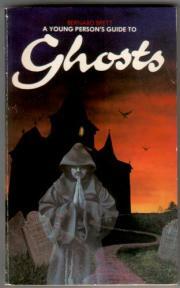
James: We had a huge collection of plastic dinos too didn’t we?
Fox: Yes! Dimetrodon was my favourite dinosaur, but they don’t think Dimetrodon was a dinosaur any more!
James: This may be a tangent.
Fox: Heh.
James: How did monsters relate to art and to feelings?
Fox: Well they relate to art because a lot of what we wanted to draw was mythical creatures like dragons.
They relate to feelings because, when we reached double figures and things got really bad, we started reading authors like Stephen King, Dean Koontz and James Herbert. We thought that reading horror books would help us to be less scared in our real life – like maybe we could get used to facing frightening things by reading those books, and become braver.
James: And did our monster love get suppressed too?
Fox: I think so. We once tried to do a book review of a horror book in school and they didn’t like that. It wasn’t a proper book like the ones you were meant to read. When we studied psychology at university – and afterwards – we were always drawn to monster-y topics, like the paranormal, and why people do evil things, and the meaning of fairy tales. But those things were always looked down on as not proper, so we wound up doing our projects on other stuff – somehow making it acceptable.
James: And yet our PhD was on loneliness, our first paper was about goths and Pagans, and the first conference we organised was about vampires. We kept finding our way back to feelings and monsters didn’t we?
Fox: All the way through. Like we did the A levels that people said we should do, instead of the ones we really wanted to do (drawing and stories!) But we spent the whole summer after we finished those exams painting our room with a giant dragon, even though we were just about to move out of there. Then after our PhD we started writing fiction. We were going to do a whole collection of alternative fairy tales and take a creative writing course, but we didn’t get accepted. For a long time we’ve had an idea for a book called Everyday Horrors: a mash up of horror fic and self-help.

James: It seems like we’ve been trying to make Welcome Monster Feelings our whole life, and finally, we’re making it, now that we’re nearly fifty.
Fox: Speak for yourself old man!
James: *Grin*
Reclaiming lost things
Fox: It’s like reclaiming isn’t it? By reclaiming art, and reclaiming monsters, we’re also reclaiming those feelings and the parts who hold them. No part gets left behind.
James: Absolutely. I couldn’t agree more. And I suspect that many people have a similar history – at least with feelings and with art. The world, and the people around them, tell them that they mustn’t show their feelings, and that they ‘can’t draw’.
Fox: That’s why we love Lynda Barry, who we mention in the zines. She says that most kids just naturally tell stories with pictures, but then they get taught proper writing and proper drawing, and they lose all that. Her books and resources are all about getting it back, by playing with it, using wax crayons, drawing quickly, colouring in, that kind of thing. And lots of drawing from the imagination!
James: I notice that when we can allow you – Fox – to just draw from the feeling (with the odd bit of help from Google images to see what certain things look like) it just comes out looking right.
Fox: It’s amazing. Morgan is often sure there’s no way it’ll come out looking like we feel it, but it really does. It’s all about keeping it simple, not trying too hard, just getting the feeling down.
James: I think Lynda Barry is helping people get back to the child part of themselves who can draw that way, and tell stories too. The part like you that perhaps everyone has somewhere inside.
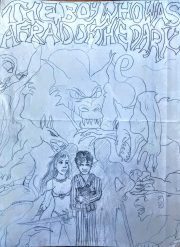
An early attempt to welcome monster feelings?
Fox: More questions please!
Inspirations
James: Well you’ve mentioned Lynda Barry. Can you say something about your other inspirations for this project?
Fox: I guess there are two kinds of inspirations: other people who’ve used monsters as a way of exploring feelings, and other people who have come up with practices for welcoming feelings.
For the first one we’re super inspired by Pixar movies. They are something we watch a lot of because they are so gentle, and we generally need that in the evenings. Inside Out and Monsters Inc are the obvious ones, but lots of the Pixar shorts explore trauma and plurality too. Far From the Tree and Twenty Something are great examples.
We also recently watched the movie A Monster Calls, which is all about monsters and fairy tales as ways of dealing with huge tough feelings. Hannah Eaton’s graphic novel, Naming Monsters, is about that too.
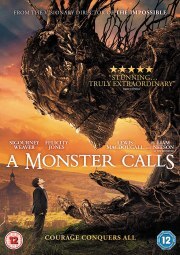
We really love this Zen Pencils comic version of Rumi’s poem, The Guest House, by Gavin Aung Than. That poem captures the whole idea of welcoming feelings better than anything else, which is why we included it at the start of the zine.
James: What about the practices for welcoming feelings?
Fox: We wrote about focusing and Pema’s F.E.A.R. practices in our Staying With Feelings zine. Those are about feeling feelings in the body. Our therapist helped us towards the idea of visualising feelings. She suggested imagining the feeling you’re having as just one cell of the body, and picturing it outside of yourself, describing what it looks like: its colour, texture, that kind of thing. That helps it be more manageable – it’s not all of you, just one cell, and it’s outside of you so you can approach it curiously.
James: Externalising the feeling, so it doesn’t feel like all that you are and all that you’ll ever be, as traumatic feelings often feel.
Fox: Right. But cells aren’t much fun. I think that imagining feelings as monsters makes it more playful. And you can do with a bit of lightness and humour when you’re dealing with something that hard.
James: Agreed. And that makes it a bit more like the Tibetan demon feeding practice that we’ve written about before.
Fox: Except in that practice you don’t tend to draw the feelings. Lynda Barry adapts a Zen practice where you draw your demons in her comic One! Hundred! Demons!
James: It’s so cool that you’re now part of this group of comic and animation creators who’ve explored monsters in this kind of way.
Fox: I know, I love that. It’s what I’ve always wanted.
James: We found our long, slow way towards art, monsters, and feelings, didn’t we?
Fox: We sure did!
Monster feeling practice
James: I know that you’ve also made a companion zine called Welcoming Your Monster Feelings. Do you want to say something about that?
Fox: Yes. We wanted to find a way to share our practice with people, in case they might find making monsters about their feelings helpful too. We were going to finish the Welcome Monster Feelings zine with a few pages about how to do it. But our friend H said they thought we shouldn’t do that, because it should stand on its own as art!
James: What did you think about that?
Fox: I think they were right. Because we still struggle to see ourselves as someone who can legitimately draw pictures or tell stories, we often want to wrap those things up in a kind of self-help project, like we used to do with academic projects. Publishing Welcome Monster Feelings as a standalone book of our art felt really important. But we did still want to share the practice, so I made an extra little zine about that.
James: And do you describe your process in that zine?
Fox: Not exactly, because I know that not everybody will work the way that we do. The zine explores all kinds of different ways people might access their feelings and turn them into monsters, and the different reasons they might find that helpful.
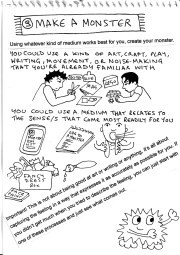
James: Can you share a bit more about your process here then. That’s something people often want to know about artists.
Fox: Heh that still sounds funny – artist. What I do is I sit down, usually with Robin or Morgan. That means that we’re… what is it?
James: Co-conscious. That’s the word for when two parts of a plural system are foregrounded at the same time, like you and I are right now.
Fox: Cool. So the other part really tunes into their feeling, and kind of shows me and tells me what it’s like. Sometimes we feel it inside our body, and sometimes we have an image. Like that last feeling in the book from Morgan – we got a strong image of that classic Peanuts comic where Lucy pulls the ball away from Charlie Brown.
After they’ve shared the feeling, I find a way to turn it into a monster picture. And I draw, with a mechanical pencil, whatever comes out. I like to draw in this sketch book we got from WHSmiths, it has a hard cover so it looks like a proper book. And that means you can’t just rip out pages if you don’t like it. It feels important that we keep them all – however they come out. That’s part of the welcoming.
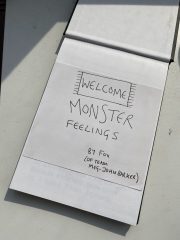
Once it feels like I’ve got the sketch right I go over the pencil lines with drawing pens. I like the ones that have several different sizes. Then I rub out the pencil lines, and we do the colouring in. That’s very soothing and often we do it together. I like these felt-tips which have a brush end and a fibre tip end. It feels good to use felt-tips because that’s more child-like than pastels or pencil crayons or paints I think. And I like the bright colours.
James: We might need to get you some more of those felt tips for your birthday. We’re close to using some of them up.
Fox: I’d like a bigger set because there’s only one grey and it doesn’t come out great on the scanner. There is a really big set you can get, just saying.
James: Heh, that is a whole lot of felt-tips.
Trauma, shame and monster feeling practice
Fox: Can I ask you a question?
James: Unconventional, but fire ahead.
Fox: Well you’ve written a graphic guide about trauma and mental health, which goes pretty well with my zine, right?
James: I guess I was the main author of that one – on behalf of the whole system and what we’ve just been through. It’s like the grown up version of your zine in some ways – except not that grown up because it’s still a comic with lots of superhero references. Hopefully Jules will be illustrating that one this year and it’ll be out in 2023.
Fox: Grown up books take a lot longer it seems.
James: *grin* I do think they go well together though, you’re right. What was the question?
Fox: I wondered why you think monster feeling practice is so helpful, given all the stuff you’ve learnt about trauma.
James: Ah yes, I do have a few thoughts about that. One thing that we explore in the graphic guide is how trauma is often the result of violence combined with silence: painful things that happen to someone which aren’t heard or held by anyone around them. We realised that many of the things that help with mental health struggles – like meditation, therapy, or activism around social injustice – are about the opposite of violence and silence – they are about kindness and honesty. Make sense?
Fox: Kindness is the opposite of violence, and honesty is the opposite of silence.
James: Right. And drawing monster feelings is all about being more honest with ourselves about what our feelings actually are, and more kind around them – that gentle process of drawing them and colouring them in, and the whole idea of welcoming them rather than trying to eradicate them.
Sharing those feelings with ourselves is also a great way to connect more with the different parts of us – to really hear what it’s like for them and to hold them in their tough places.
Fox: The holding and hearing monster! Kind holding and hearing the truth.
James: Yes! The zine also helps us to connect with other people when they resonate with your drawings. That’s a way of healing the disconnection (with self, others, and the world) which lies at the heart of so much trauma.
Fox: But why is it so important for us to be able to feel the monster feelings?
James: Ara and I explored this a bit last year in our Staying with the Big Feels blog post. One reason is that it’s hard for a person to be authentic – to be real about who and how they are – without all of their feelings. And it’s hard to have real intimacy – or good relationships – with other people too if you’re still hiding some of your feelings from yourself and/or from them. Being able to be yourself, and having good relationships, are both vital for mental and physical health.
Another thing is that the feelings that many people, including us, most often avoid or repress are the most vital for self-protection and for caring for others. Robin has held much of our fear, and Morgan much of our anger. We’ve realised recently how those feelings are so important for keeping ourselves safe-enough and for acting with integrity.
Fox: The integri-tree!
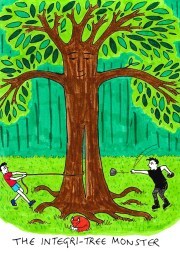
James: That’s right, you drew a few pictures relating to this. Robin’s fear of shame – when it isn’t unbearably intense – helps to guide us in what we take on, and what we don’t, recognising when other people are trying to pull us or push us into things, or when it’s coming from a dodgy motivation inside us. Morgan’s anger – when it isn’t twisted into confusion – helps us to state our needs and boundaries, as well as seeing other people more clearly. Your anger sunshine picture captured this beautifully.
Fox: Thank-you.
James: There’s lots more I could say about this, but the point is that without access to some of the supposedly ‘negative’ feelings, it’s very hard to empathise with others, to recognise danger, and to value ourselves equally with other people, rather than seeing ourselves as worse-than, or better-than.
Fox: For us it’s often worse-than. That’s why a lot of our pictures are about shame.
James: Mm, and it’s very common for shame to be at the heart of people’s tough feelings as Brené Brown has pointed out. We’ve been reading a lot about shame since we did a workshop on the topic last year, linked to the shame and medicine project.
The book we’re reading right now says that it’s very hard to express shame verbally because it’s often non-conscious and not available to the language parts of the brain. So perhaps you’ve really hit on something with these drawings – giving us a way to communicate feelings that would be impossible to express in any other way.
Fox: Wow.
James: I know right? And it’s vital because so much of what people do that hurts them and others is an attempt to avoid painful feelings – particularly shame and the fear of shame. If we were able to get to a point where we were okay with all those feelings – where we could weather them, if not actively welcome them – then potentially we wouldn’t do those hurtful things. It’s a lifelong journey though, as Pema would say.
Fox: Life long, and many books of monster feelings!
Where next?
James: That’s a great segue to the final question I have for you. Where are you hoping to go next in your creative pursuits, now that you’ve got us here.
Fox: Well I’ve already started Welcome More Monster Feelings, so that we’ll keep going. Most of the monsters in the first book were Robin’s ones, partly because he was foregrounded for a lot of the time we were making it, and partly because Morgan initially didn’t want to do her feelings because she struggles so much not to be critical of them.
James: She really didn’t like the volcano drawing you made of her rage.
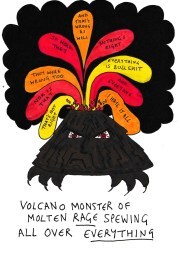
Fox: I knew that would happen! It’s the only one where the colours ran, and you can’t see the face very well. But then I did the one of her snake-eating-its-tail, and the sunshine anger, and she loved those, so I think she’s on board now. She has quite a few more monsters to share.
James: Anything else you want to do, or is it all monsters all of the time?
Fox: I would like to make more plural zines now that we all know each other better. I’ve started one about how people can learn to love their different parts, and there’s another one to do about how they can communicate better between them.
But I also want to listen to H and do some more stuff that’s just about our own experiences – not trying to be a self-help thing. Maybe I could do more plural comics like the Chalk Board one. Also I think Morgan would love to write about our journey of embracing our inner critic, perhaps with fairy tales!
James: It would be great if she could feel free enough to create herself. She has such a powerful and tender voice when she can find it through all the horrors she’s experienced.
Fox: Totally.
James: Okay. Well thank-you very much for sharing some of your precious time with me today Fox, and for joining me at the keyboard instead of the sketchpad for once.
Fox: You are very welcome. I expect extra cuddles later.
James: You got it. And I hear there’s a new Ghostbusters movie…
Find out moreFor more on this topic check out our monsters and feelings zines, and our workbook with Alex Iantaffi, Hell Yeah Self Care.Patreon link: If you enjoyed this please feel free to support our Patreon.Plural tag: This post was by Fox and James.
The post On monsters, emotions, and drawing: An interview with the artist behind the zine ‘Welcome Monster Feelings’ appeared first on Rewriting The Rules.
Meg-John Barker's Blog
- Meg-John Barker's profile
- 333 followers


